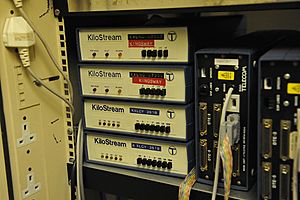Packet Switch Stream facts for kids
Packet Switch Stream (PSS) was an early computer network in the United Kingdom. It was like an early version of the internet, letting computers talk to each other. The British Post Office Telecommunications and later British Telecommunications (BT) started it in 1980. After some tests, it officially launched on August 20, 1981. PSS replaced an older test network called EPSS.
Contents
Connecting to PSS
Companies and people could connect to the PSS network in a few ways. One way was using a special X.25 connection. This needed a dedicated phone line and a PSS analog modem. Later, they could use a digital line called Kilostream. Getting these special lines could take a long time back then, sometimes over six months!
Another way to connect was simpler, using a basic connection called RS232/V.24. This was like plugging in a simple computer terminal. You would connect to a special device called a PAD (Packet Assembler/Disassembler). Many people chose to dial into a public PAD using a regular phone line and an analog modem. This was cheaper. Think of it like how you connect to the internet today, either with a fast broadband connection or by dialing up. Some businesses even bought their own PADs. PSS was one of the first networks in the UK where customers could connect their own equipment. This happened before BT became a private company in 1984.
Connecting to Databases
PSS was used to connect to many online databases and large computer systems. A very important use was for the first networked Clearing House Automated Payment System (CHAPS). This system was used to send very large payments (over £10,000) between major UK banks. Before CHAPS, banks used a paper system with special electric vehicles to move documents around London.
How Fast Was PSS?
PSS offered different connection speeds. Faster lines cost more money to rent. The fastest lines used services like Megastream (2 Mega bits per second) and Kilostream (256 kilo bits per second). Slower analog lines offered speeds like 2,400, 4,800, 9,600, and 48,000 bits per second.
Individual users could connect to PSS by dialing in with a PSTN modem. Speeds for these dial-up connections ranged from 110 to 2,400 bits per second. In the 1980s, 1,200 bits per second was a common speed.
History of PSS
Before PSS even started, an international version called International Packet Switch Stream (IPSS) began in 1978. This was because many people wanted to access databases in the US. IPSS helped connect PSS to other packet-switched networks around the world.
For a short time, Europe had its own network called Euronet. It also had a project called Diane to help develop more online services in Europe. These connections later moved to PSS and other European networks as they became available.
The PSS network was built using special computer hardware from a company called DCC. The software that made the network work was developed by Telenet. BT bought this system through a company called Plessey Controls.
Later, BT also bought other network systems, including the Tymnet network. BT wanted to offer global network services to large companies. This idea was later part of a company called Concert.
The End of PSS
The very last PSS connection in the UK was finally turned off on June 28, 2006. The network was managed by special computers located in London and Manchester.
BT's leaders were not always sure about packet switching. They thought it was just a temporary thing until faster connections like ISDN became common. They even said the internet was "not fit for purpose" in its early days.
Challenges for PSS
PSS faced problems with money and management decisions in its early years. Sometimes there wasn't enough investment, and sometimes money was spent on the wrong things.
For example, BT tried to develop its own network hardware and applications. This cost a lot of money and delayed the network from making a profit. There was also an attempt to create a joint company with IBM, but the UK government stopped it because they thought it would harm competition.
One successful use of PSS was for transaction phones. These phones were used by shops to check credit cards and prevent fraud. The idea was to put a small packet switch in every local telephone exchange to support these low-speed uses. However, this added a lot of costs without bringing in much extra money.
Eventually, new management was brought in, and they focused on making PSS run efficiently and cutting unnecessary costs. PSS finally started making a profit around 1988. It was then combined with other struggling BT services.
What Happened Next?
PSS, like all X.25 networks, was eventually replaced by the internet. The internet offered better applications and was cheaper to use. BT made some mistakes regarding the internet and its international operations.
BT struggled to become the main internet provider in the UK for a while. Other companies like Dixon's Freeserve became very popular. This only changed after BT got new senior leaders who focused on broadband and the internet.
Now, BT is becoming a major player in global network services. This is because modern networks use packet switching technology, which PSS helped to pioneer.
See also
- Internet in the United Kingdom § History
- NPL network
- Telecommunications in the United Kingdom


